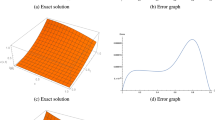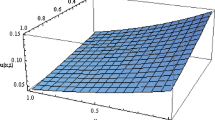Abstract
This study makes the first attempt to extend the meshless boundary-discretization singular boundary method (SBM) with time-dependent fundamental solution to two-dimensional and three-dimensional scalar wave equation upon Dirichlet boundary condition. The two empirical formulas are also proposed to determine the source intensity factors. In 2D problems, the fundamental solution integrating along with time is applied. In 3D problems, a time-successive evaluation approach without complicated mathematical transform is proposed. Numerical investigations show that the present SBM methodology produces the accurate results for 2D and 3D time-dependent wave problems with varied velocities c and wave numbers k.























Similar content being viewed by others
References
Young DL, Gu MH, Fan CM (2009) The time-marching method of fundamental solutions for wave equations. Eng Anal Bound Elem 33:1411–1425. doi:10.1016/j.enganabound.2009.05.008
Chen KH, Chen JT, Chou CR, Yueh CY (2002) Dual boundary element analysis of oblique incident wave passing a thin submerged breakwater. Eng Anal Bound Elem 26:917–928. doi:10.1016/S0955-7997(02)00035-8
Šarler B (2009) Solution of potential flow problems by the modified method of fundamental solutions: Formulations with the single layer and the double layer fundamental solutions. Eng Anal Bound Elem 33:1374–1382. doi:10.1016/j.enganabound.2009.06.008
Zienkiewicz OC, Taylor RL (1991) The finite element method, 4th edn. McGraw-Hill, New York
Avilez-Valente P, Seabra-Santos FJ (2004) A Petrov–Galerkin finite element scheme for the regularized long wave equation. Comput Mech 34:256–270. doi:10.1007/s00466-004-0570-4
He ZC, Liu GR, Zhong ZH, Zhang GY, Cheng AG (2010) Dispersion free analysis of acoustic problems using the alpha finite element method. Comput Mech 46:867–881. doi:10.1007/s00466-010-0516-y
Chen KH, Chen JT (2006) Adaptive dual boundary element method for solving oblique incident wave passing a submerged breakwater. Comput Method Appl Mech 196:551–565. doi:10.1016/j.cma.2006.06.002
Cheng AHD, Cheng DT (2005) Heritage and early history of the boundary element method. Eng Anal Bound Elem 29:268–302. doi:10.1016/j.enganabound.2004.12.001
Carrer JAM, Mansur WJ, Vanzuit RJ (2009) Scalar wave equation by the boundary element method: a D-bem approach with non-homogeneous initial conditions. Comput Mech 44:31–44. doi:10.1007/s00466-008-0353-4
Chen CS, Karageorghis A, Smyrlis YS (2008) The method of fundamental solutions—a meshless method. Dynamic Publishers, Atlanta
Gu MH, Young DL, Fan CM (2009) The method of fundamental solutions for one-dimensional wave equations. Comput Mater Contin 11:185–208. doi:10.3970/cmc.2009.011.185
Chen CS, Fan CM, Monroe J (2008) The method of fundamental solutions for solving elliptic partial differential equations with variable coefficients. In: Chen CS, Karageorghis A, Smyrlis YS (eds) The method of fundamental solutions-a meshless method. Dynamic Publishers Inc, Atlanta, pp 105–175
Tan SR, Huang LJ (2014) An efficient finite-difference method with high-order accuracy in both time and space domains for modelling scalar-wave propagation. Geophys J Int 197:1250–1267. doi:10.1093/gji/ggu077
Chen HM, Zhou H, Zhang QC, Xia MM, Li QQ (2016) A k-space operator-based least-squares staggered-grid finite-difference method for modeling scalar wave propagation. Geophysics 81:T39–T55. doi:10.1190/geo2015-0090.1
Kim J, Kim D, Choi H (2001) An immersed-boundary finite-volume method for simulations of flow in complex geometries. J Comput Phys 171:132–150. doi:10.1006/jcph.2001.6778
Anastasiou K, Chan CT (1997) Solution of the 2D shallow water equations using the finite volume method on unstructured triangular meshes. Int J Numer Meth Fluids 24:1225–1245. doi:10.1002/(SICI)1097-0363(19970615)24:11<1225:AID-FLD540>3.0.CO;2-D
Rabczuk T, Belytschko T (2004) Cracking particles: a simplified meshfree method for arbitrary evolving cracks. Int J Numer Methods Eng 61:2316–2343. doi:10.1002/nme.1151
Nguyen VP, Rabczuk T, Bordas S, Duflot M (2008) Meshless methods: a review and computer implementation aspects. Math Comput Simul 79:763–813. doi:10.1016/j.matcom.2008.01.003
Fu ZJ, Chen W, Yang W (2009) Winkler plate bending problems by a truly boundary-only boundary particle method. Comput Mech 44:757–763. doi:10.1007/s00466-009-0411-6
Chen W, Wang FZ (2010) A method of fundamental solutions without fictitious boundary. Eng Anal Bound Elem 34:530–532. doi:10.1016/j.enganabound.2009.12.002
Xu SZ (1995) The boundary element method in geophysics. Science Press, Beijing
Brebbia CA (1981) Progress in boundary element methods, vol 2. Springer, New York
Cheng AHD, Young DL, Tsai CC (2000) Solution of poisson’s equation by iterative DRBEM using compactly supported, positive definite radial basis function. Eng Anal Bound Elem 24:549–557. doi:10.1016/S0955-7997(00)00035-7
Li JP, Chen W, Fu ZJ (2016) Numerical investigation on convergence rate of singular boundary method. Math Probl Eng 2016:1–13. doi:10.1155/2016/3564632
Wei X, Chen W, Sun LL, Chen B (2015) A simple accurate formula evaluating origin intensity factor in singular boundary method for two-dimensional potential problems with Dirichlet boundary. Eng Anal Bound Elem 58:151–165. doi:10.1016/j.enganabound.2015.04.010
Sun LL, Chen W, Cheng AHD (2016) Singular boundary method for 2D dynamic poroelastic problems. Wave Motion 61:40–62. doi:10.1016/j.wavemoti.2015.10.004
Chen W, Zhang JY, Fu ZJ (2014) Singular boundary method for modified Helmholtz equations. Eng Anal Bound Elem 44:112–119. doi:10.1016/j.enganabound.2014.02.007
Fu ZJ, Chen W, Chen JT, Qu WZ (2014) Singular boundary method: three regularization approaches and exterior wave applications. CMES-Comput Model Eng 99:417–443. doi:10.3970/cmes.2014.099.255
Li JP, Fu ZJ, Chen W (2016) Numerical investigation on the obliquely incident water wave passing through the submerged breakwater by singular boundary method. Comput Math Appl 71:381–390. doi:10.1016/j.camwa.2015.11.025
Fu ZJ, Chen W, Gu Y (2014) Burton–Miller-type singular boundary method for acoustic radiation and scattering. J Sound Vib 333:3776–3793. doi:10.1016/j.jsv.2014.04.025
Acknowledgments
The work described in this paper was supported by the National Science Funds of China (Grant Nos. 11302069, 11372097, 11572111), the Chinese Postdoctoral Science Foundation (Grant Nos.2014M561565, 2015T80492), and the Foundation for Open Project of the State Key Laboratory of Acoustics (Grant No. SKLA201509), the Foundation for Open Project of the key laboratory of road construction technology and equipment, ministry of education (Grant No. 310825151132), the 111 Project (Grant No. B12032).
Author information
Authors and Affiliations
Corresponding author
Appendix: The detailed derivation of Eq. (13)
Appendix: The detailed derivation of Eq. (13)
The derivation of Eq. (13) will be provided via a circle domain with uniformly distributed points. It is beyond our capability to derive this formula in more general situations. However, our numerical experiments show that Eq. (13) can be extended to irregular domains with non-equally distributed points.
Consider a 2D Laplace equation on Dirichlet boundary condition
where \(\nabla ^{2}\) denotes the Laplacian operator, u(x) represents the potentials in domain \(\Omega \), \(\bar{{u}}(x)\) is the known function, \(\Gamma _D \) represents the Dirichlet boundary conditions.
The formulation of the SBM can be stated as

where \(G_0 (x_m ,s_n )=\ln (r_{mn} )\) is the fundamental solution of 2D Laplace equations, \(U_0^m \) the source intensity factors, \(\alpha _n \) the unknown coefficient.
Consider \(\Omega \) a circle with radius R. \(\left\{ {x_m } \right\} _{m=1}^N \) denote the collocation and source points uniformly placed on the boundary \(\partial \Omega \). \(L_n \) represents the length of the auxiliary line in 2D as shown in Fig. 5.
For \(x_m \in \partial \Omega \), it is easy to verify that the following contour integral is zero.
where r is the distance between \(x_m \) and source points s on the circle. Eq. (34) can be discretized as
Due to the symmetry property of the circle, the derivation is independent of the indices of the collocation points. \(m=1\) is used in the following derivation. Hence, we have
where \(x_1 =(1,0)\). Notice that
Substituting Eq. (37) into Eq. (36), and define the desingularized value of the natural logarithm function as a,
The key issue is to determine the value of \(\prod \nolimits _{n=2}^N {\sin \left( \frac{n-1}{N}\pi \right) } \). Let \(\omega =\cos (2\pi /N)+i\sin (2\pi /N)=\exp (2\pi i/N)\). Note that \(\omega \) is a solution of the equation
Similarly, \(\omega ^{2},\omega ^{3},...,\omega ^{N-1}\) are also the solution of Eq. (39). After some algebraic manipulations, Eq. (39) is equivalent to
For \(z=1\), we obtain
It follows that
Since
We have
Therefore,
From Eqs. (38) and (45), we have
It follows that \(U_0^m \) for the natural logarithm function is
where \(L_m =2\pi R/N\).
Rights and permissions
About this article
Cite this article
Chen, W., Li, J. & Fu, Z. Singular boundary method using time-dependent fundamental solution for scalar wave equations. Comput Mech 58, 717–730 (2016). https://doi.org/10.1007/s00466-016-1313-z
Received:
Accepted:
Published:
Issue Date:
DOI: https://doi.org/10.1007/s00466-016-1313-z




